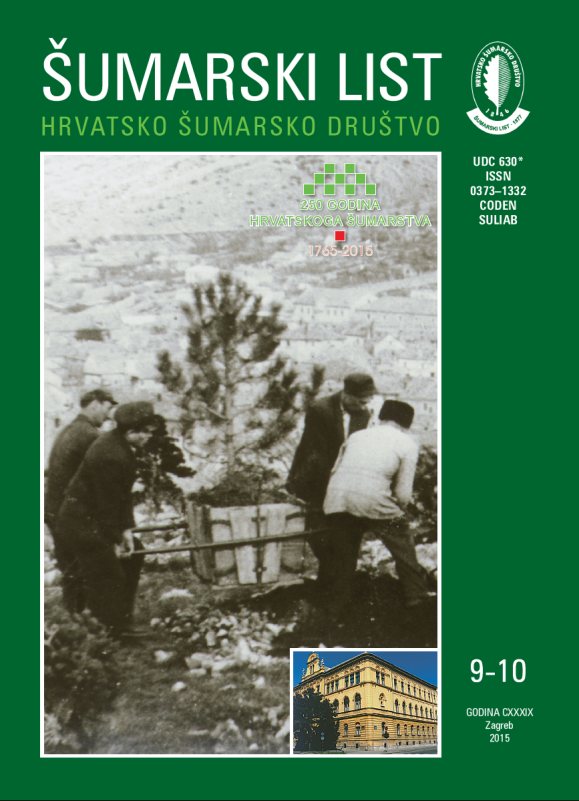
broj: 9-10/2015
pdf (10,58 MB) |
|
||||||||||||||
| RIJEČ UREDNIŠTVA | ||
| Uredništvo | ||
| HAVE WE LEARNT SOMETHING FROM HISTORY?
pdf
HR
EN
digitalna biblioteka HŠD: Politika i korupcija |
417 | |
| IZVORNI ZNANSTVENI ČLANCI | ||
| Željko ZEČIĆ, Željko TOMAŠIĆ, Tomislav TOPALOVIĆ, Dinko VUSIĆ | UDK 630*537 (001) | |
| INDIGOBUSH BIOMASS PRODUCTION IN MANAGEMENT UNIT „SLAVIR“ pdf HR EN | 419 | |
| Marko ZEBEC, Marilena IDŽOJTIĆ, Igor POLJAK, Ines MODRIĆ | UDK 630*164 (001) | |
| POPULATION VARIABILITY OF WYCH ELM (Ulmus glabra Huds.) IN THE MOUNTAINOUS REGION OF CROATIA ACCORDING TO THE LEAF MORPHOLOGY pdf HR EN | 429 | |
| Toni KOREN, Stanislav GOMBOC | UDK 630*453 (001) | |
| FIRST RECORD OF Chersotis rectangula ([Denis & Schiffermüller], 1775) IN CROATIA WITH NEW DATA FOR Chersotis Multangula (Hübner, 1803) (Lepidoptera: Noctuidae) pdf HR EN | 441 | |
| Erol AKKUZU, Hidayet GUZEL | UDK 630*453 (001) | |
| EDGE EFFECTS OF Pinus nigra FORESTS ON ABUNDANCE AND BODY LENGHT OF Ips sexdentatus pdf HR EN | 447 | |
| Summary Ips sexdentatus (Börner, 1776) (Coleoptera: Curculionidae: Scolytinae) is one of the most devastating pests of coniferous forests in Turkey. The pest not only kills individual host trees, but also it can outbreak readily and cause great damage under favorable conditions. Distribution and damage of this pest vary depending on some biotic and abiotic factors (e.g. edge effect, climatic factors, and host plant). The present study investigated the edge effect of Pinus nigra Arnold stands on the population level and the body length of I. sexdentatus. For this purpose, edge effects of P. nigra forests on I. sexdentatus were studied at Kastamonu Regional Directorate of State Forests located in northwestern black sea region of Turkey in the years 2012–2013. Three factors (forest interior, forest edge, and forest exterior) were used to test the effects of forest edges on the abundance and body length of I. sexdentatus. A number of five study sites were selected to deploy Lindgren® funnel-type pheromone traps. Fifteen-unit traps baited with commercial pheromone Ipssex® were set in 5 replicate blocks of three traps per block. The results of the study were as follows: 1) Double bark thicknesses and diameter of the trees along the forest edges were significantly higher than those in forest interior; 2) The number of I. sexdentatus captured from forest outside and forest edge was significantly higher than those in forest interior; 3) Body length of I. sexdentatus was significantly higher on trees along the forest edges than those in forest interior. Key words: Pinus nigra; bark beetles; forest edges; Turkey | ||
| PRETHODNO PRIOPĆENJE | ||
| Milka GLAVENDEKIĆ, Bojana IVANOV, Milanka DŽINOVIĆ, Branka ARSOVIĆ, Danimir MANDIĆ | UDK 630* 945.4 + 411 (001) | |
| EDUCATIONAL TECHNOLOGY IN DEVELOPING PUBLIC AWARENESS OF TREE PESTS AND PATHOGENS pdf HR EN | 455 | |
| STRUČNI ČLANCI | ||
| Ivo AŠČIĆ | UDK 630*945.2 | |
| THE CONTRIBUTION OF POSTAGE STAMPS IN PROMOTING FORESTRY pdf HR EN | 465 | |


